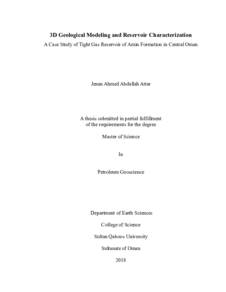Document
3D geological modeling and reservoir characterization a case study of tight gas reservior of amin formation in central Oman
Publisher
Sultan Qaboos University
Gregorian
2018
Language
English
Subject
English abstract
This project is proposed to study a deep siliciclastic tight gas reservoir in one of the fields in central part of Oman. It produces gases from the Cambrian Amin Formation, which was deposited in arid continental setting; alluvial fan, fluvial and aeolian depositional system. The common lithology units found in Amin Formation are sandstone, siltstone and conglomerate. The project presents the result of building 3D geological model carried out by using petrel software. The model consists of faults, pillar gridding, horizons, zones and layers; all these were integrated to present the final 3D geological model of Amin gas reservoir to resemble the reservoir in reality. The gas volume calculated from this model is 1126.20×109 m3. Twenty-two wells have been used for stratigraphic correlation to divide the Amin Formation in the studied field into eleven units. The used wireline logs are gamma ray, neutron, density, resistivity and calculated porosity from density. Textural analysis and detail petrographic description were created by using Axio Vision and Petrolog Software to study reservoir characterization and quality. Thirty-three thin sections from two wells were used for textural analysis, mineral composition and diagenetic alterations of Amin Formation. The grain sizes range from coarse sand (1 mm- 0.5 mm) to very fine sand (0.125 mm- 0.0625 mm). However, sorting range from well sorted (0.35 Ø- 0.50 Ø) and moderately well sorted (0.50 Ø- 0.71 Ø). The observed sandstones of Amin Formation is quartz arenite (Q91.86F8.13L0) in composition. The main diagenesis processes encountered in the studied Amin Formation are cementation by quartz overgrowth, dolomite and compaction (i.e. mechanical and chemical) which resulted in porosity reduction and thus reservoir quality deterioration. On other hand, dissolution of chemically unstable silicate grain resulted in porosity creation (i.e. moldic porosity) and thus reservoir quality enhancement. The results of this work have academic and economic significance. Regarding to the academic sector is to learn how to build 3D geological model, exposure to oil and gas business and analyzing of thin sections in terms of textural analysis, mineral composition and diagenesis process. Whereas, the economic significant are to estimate and make assessment regarding to improving the field production after use the 3D geological model as input for dynamic reservoir simulation, adding more wells, predict the future production and find alternative scenarios for future development plane
Description
Thesis
Member of
Resource URL
Category
Theses and Dissertations







